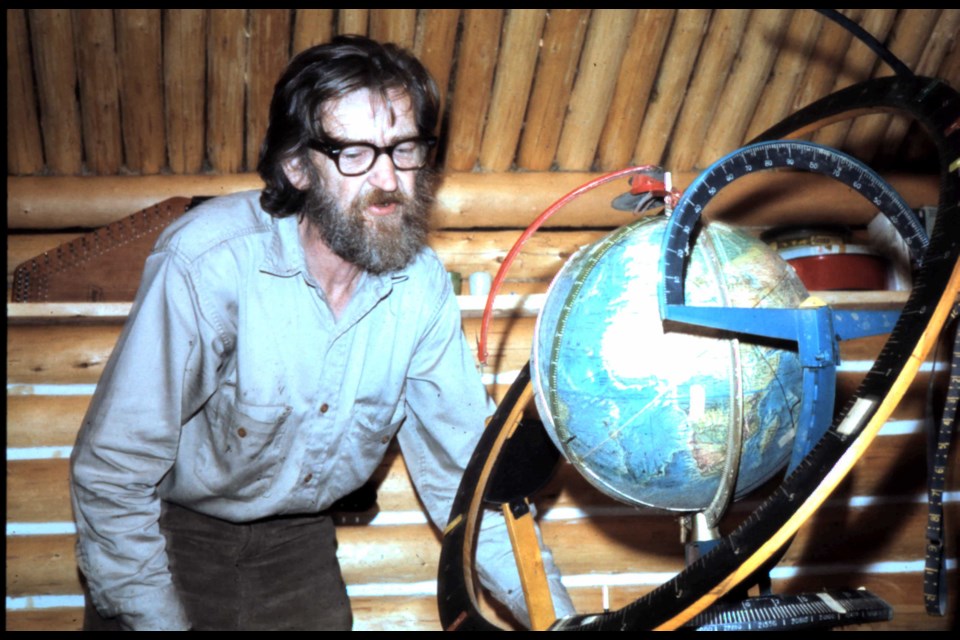THUNDER BAY - On an island in the middle of Whitewater Lake deep in the Northwestern Ontario wilderness are the rundown remains of beautifully designed and handcrafted log cabins.
When cinematographer, Sarah Furlotte, visited that island this year, she was struck by the space, and even more so by the story behind it.
“There is something kind of captivating about an abandoned space,” she said. “You always think about what went on here, what happened here, what was the life force here?”
Wendell Beckwith, the life that once occupied that abandoned space, has become somewhat of a folklore legend in Northwestern Ontario and now his story is being brought back to life in a new film.
Filmmaker Jim Hyder is partnering with the Thunder Bay Museum to produce a documentary that will tell the story of Beckwith’s life through his many intricate scientific gadgets, his artistic woodwork, and the people who knew him.
“The cabins and Wendell are sort of a piece of Northwestern Ontario folklore,” Hyder said. “People have come from all over to see the place. It’s a story that’s never really been told. Not in total. I think it’s a piece of history.”
Beckwith was born in 1915 in Connecticut and later lived in Wisconsin. He had little formal training in science or engineering but he was credited as the inventor of the sapphire nib for Parker Brothers Ball Point Pens.
His mind was always fascinated with larger scientific concepts like gravity, magnetism, and the universe. In 1961, having already left his wife and children and leaving them with a trust, Beckwith worked briefly at the Gravity Institute in New Hampshire, before meeting Harry Wirth, a wealthy businessman who wanted to start a wilderness retreat in Northern Ontario.
“He and Harry were looking for a place that was isolated,” Hyder said. “They were reclusive and wanted a place in the wilderness that nobody would go to, and that is what drove them here in the first place.”
“What he wanted was to get away from the applied science and into a science where he could expand his mind and understand the workings of the universe and the earth.”
Beckwith and Wirth built several cabins on Best Island in the middle of Whitewater Lake, which is located approximately 40 kilometres north of Armstrong, Ont.
While there, Beckwith pursued his interests in science and engineering, crafting intricate devices out of wood to make scientific measurements, as well as artistic models and sculptures. He also helped build the cabins, which were once a popular destination for travellers in the region but have since fallen into disrepair.
“The cabins are a wonderful piece of woodwork and artistry that have been left and not maintained,” Hyder said. “This will open the question again about what should happen with those. This is a treasure.”
According to Hyder, Beckwith was not much of an outdoorsman and he did not hunt or fish. He became close with local Indigenous people in the area, who most likely helped keep him and Wirth alive during their first few years on the island. Beckwith remained on Best Island until his death in 1980 at the age of 65.
A film 40 years in the making
The story about this enigmatic man is one that Hyder tried to tell before. In 1972, Hyder’s brother met Beckwith and told him that he needed to meet this reclusive man.
“He was known around the Armstrong area and he was an interesting character,” Hyder said. “I was working for the National Film Board at the time. So my brother thought that maybe he would be an interesting subject for a film, in which case he was.”
Now more than 40 years later, Hyder was encouraged to return to the film project by people who visited the site and tell the story of Beckwith. Filming has already begun and a group of students from the Outdoor Recreation program at Lakehead University visited the site along with the film crew this fall.
“We came in on the beach that he tended to hang out on,” said Furlotte. “We come up from the side and the first building you see is the museum, and it is in very rough shape. It is the one that has the roof completely caved in. It was very sad. You have a really deep, sad feeling when you arrive that way.”
“It was a mix of wonder and sadness,” Furlotte continued. “It’s sad that it hasn’t been taken care of. It’s sad that we have this history that is not cared for.”
The film has received funding from the Ontario Arts Council and Hyder hopes it will be completed by the end of next summer. He said it is an ever-expanding story and the film crew is working to interview more people who knew Beckwith, because those who knew him will never forget him.
“He is the most interesting person I have met,” Hyder said. “He was a wonderful craftsman when it came to making cabins and woodwork and he was also a very different kind of scientist. Some people thought he was a hermit, but he wasn’t. He was a recluse. He was very charming. He had a great laugh and was always welcoming. He was brilliant in his own way. It was just fun being with him.”
